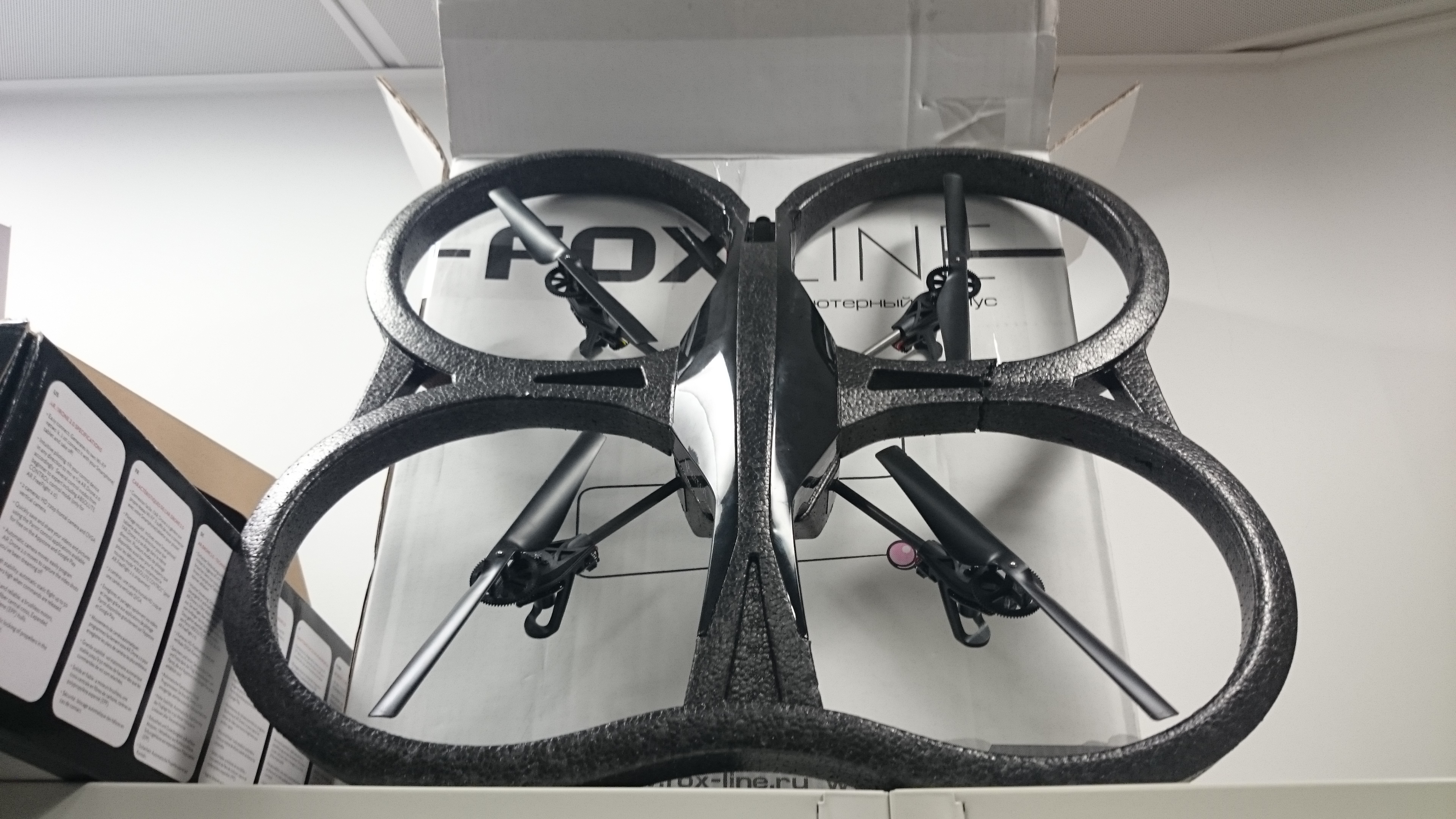Journey into the world of new technologies - drones, tracking cows, 3D printing of flying drones
Author - Lyudmila Dmitrieva
So, SAP opens its first D-Shop in Russia. What is it?
I'll start from afar to make it clearer.

Before you, for example, are the most urgent tasks. Suppose you are a director of a film for which you need to remove some place from the top point (shooting from the top point is practically a must have for any movie, whether it be art or documentary), or, for example, you are a farmer, and you need not to lose a herd of cows, followed by only one shepherd in the village, who, as everyone understands, can inadvertently fall asleep.

Or even more difficult - to determine a malfunction in the power line, the length of which is 5 thousand km. As an option - send the UAZ Loaf or the Urals with a driver who will undertake to drive (if he can through our forests, fields and swamps) this distance under the lines and will determine where the fault is.

A similar task is to periodically patrol the rail track in order to analyze its technical condition.

Or else - they brought to the apartment the furniture that you had been waiting for so long, but the suppliers forgot to put a small part in the kit, due to the lack of which you cannot fully assemble it. What to do? Turn the apartment into a warehouse and wait a few more months for this part to come from abroad?
And here is a very standard thing - a vending machine sells ice cream in the summer, but the freezer suddenly breaks. What to do? Count losses?
And now closer to the point. Such and similar tasks can be formulated, modeled, designed, and then prototyped in the SAP D-Shop, a developers workshop.
To study, play, explore - that’s all D-Shop is for. Ultimately, the idea that SAP lays in is “we are inventing something and building something here.”

The purpose of the D-Shop is to inspire its developers to new, possibly crazy ideas, propose new approaches, come up with new tasks, play with the latest technological innovations, and experiment with advanced technologies.
In D-Shop, you can really print something on a 3D printer, play with microcontrollers, build, for example, a small weather station to transmit air temperature or humidity to the analytical system in the cloud.

Here you can try to work with the drone and write software for it that will perform the task that you want to implement.
The drone can be controlled, it has several cameras. He can set points in GPS, he will take the necessary photos and return. And it can rise to a height of up to 10 thousand meters. By the way, in Europe, for example, such drones are used to deliver goods from online stores.

Inside D-Shop, there is a different combination of hard and software that you can use.
Now everyone is talking about the Industrial Revolution, Industry 4.0, 3D printers and 3D technology. This revolution is not that planned, it is already underway. Maybe we do not always notice her, but in many sectors she has already come.
The drones that are used by Americans in Iraq and Afghanistan are already printed in their entirety, i.e. not individual parts are produced, but the entire aircraft at once. And he at the same time the most surprising thing is that he flies. Those. if now you need to order spare parts, then in the case of printing, you just need to order material for the final product.
Currently, 3D technology is actively used for the manufacture of dentures, the accuracy is extremely high (much higher than the master himself will do with his hands). Such a printer is no longer worth some sky-high money, but about 20-30 K USD (they have there), which for the dental industry can pay off very quickly.
3D - Industrial printer used in the D-Shop.

You can take any 3D model

or scan it on a 3D scanner.

For example, if a kitchen item is missing, it can be scanned and printed. Even if the part is broken, it can be scanned and “repaired” on the computer.

Restrictions on the material of the printer does not exist.
Steering wheel and virtual reality goggles - here you can feel like a huge truck driver and take goods from somewhere from Milan to Paris, or ride a tank, fly a plane.

One of the scenarios for using glasses is training employees in emergency situations.

Putting on glasses, you begin to feel at the scene of an accident or accident, you see your hands in front of you, with which you can move objects or simply move around this virtual reality and learn to act correctly.
Another task is to work in a warehouse and pick (collect) orders for end consumers. Imagine how many different kinds of parts, spare parts, etc. exist, for example, for car repair? Quickly collecting an order in the presence of thousands of items is a practically impossible task. And here, too, you can use glasses that will scan barcodes on the shelves where the spare part is and verify the correctness of the positions. Using the software that is used when these glasses work, you can upload orders to the employee’s entire working day in memory, synchronize data at certain points in time, which additionally will not create a large wireless network in warehouses.
And what will the vending machine do

selling, for example, ice cream, when does the freezer break? She herself will determine that the freezer has broken down and will loudly invite everyone to buy ice cream from her, and at a very attractive price. Better not to count profits than to calculate losses.
There are many ideas, and in completely different industries, it is necessary to experiment.
Do you have any ideas? Want to share?
By the way, be sure to come to the event that SAP holds especially for bloggers. Details here .
So, SAP opens its first D-Shop in Russia. What is it?
I'll start from afar to make it clearer.

Before you, for example, are the most urgent tasks. Suppose you are a director of a film for which you need to remove some place from the top point (shooting from the top point is practically a must have for any movie, whether it be art or documentary), or, for example, you are a farmer, and you need not to lose a herd of cows, followed by only one shepherd in the village, who, as everyone understands, can inadvertently fall asleep.

Or even more difficult - to determine a malfunction in the power line, the length of which is 5 thousand km. As an option - send the UAZ Loaf or the Urals with a driver who will undertake to drive (if he can through our forests, fields and swamps) this distance under the lines and will determine where the fault is.

A similar task is to periodically patrol the rail track in order to analyze its technical condition.

Or else - they brought to the apartment the furniture that you had been waiting for so long, but the suppliers forgot to put a small part in the kit, due to the lack of which you cannot fully assemble it. What to do? Turn the apartment into a warehouse and wait a few more months for this part to come from abroad?
And here is a very standard thing - a vending machine sells ice cream in the summer, but the freezer suddenly breaks. What to do? Count losses?
And now closer to the point. Such and similar tasks can be formulated, modeled, designed, and then prototyped in the SAP D-Shop, a developers workshop.
To study, play, explore - that’s all D-Shop is for. Ultimately, the idea that SAP lays in is “we are inventing something and building something here.”

The purpose of the D-Shop is to inspire its developers to new, possibly crazy ideas, propose new approaches, come up with new tasks, play with the latest technological innovations, and experiment with advanced technologies.
In D-Shop, you can really print something on a 3D printer, play with microcontrollers, build, for example, a small weather station to transmit air temperature or humidity to the analytical system in the cloud.

Here you can try to work with the drone and write software for it that will perform the task that you want to implement.
The drone can be controlled, it has several cameras. He can set points in GPS, he will take the necessary photos and return. And it can rise to a height of up to 10 thousand meters. By the way, in Europe, for example, such drones are used to deliver goods from online stores.

Inside D-Shop, there is a different combination of hard and software that you can use.
Now everyone is talking about the Industrial Revolution, Industry 4.0, 3D printers and 3D technology. This revolution is not that planned, it is already underway. Maybe we do not always notice her, but in many sectors she has already come.
The drones that are used by Americans in Iraq and Afghanistan are already printed in their entirety, i.e. not individual parts are produced, but the entire aircraft at once. And he at the same time the most surprising thing is that he flies. Those. if now you need to order spare parts, then in the case of printing, you just need to order material for the final product.
Currently, 3D technology is actively used for the manufacture of dentures, the accuracy is extremely high (much higher than the master himself will do with his hands). Such a printer is no longer worth some sky-high money, but about 20-30 K USD (they have there), which for the dental industry can pay off very quickly.
3D - Industrial printer used in the D-Shop.

You can take any 3D model

or scan it on a 3D scanner.

For example, if a kitchen item is missing, it can be scanned and printed. Even if the part is broken, it can be scanned and “repaired” on the computer.

Restrictions on the material of the printer does not exist.
Steering wheel and virtual reality goggles - here you can feel like a huge truck driver and take goods from somewhere from Milan to Paris, or ride a tank, fly a plane.

One of the scenarios for using glasses is training employees in emergency situations.

Putting on glasses, you begin to feel at the scene of an accident or accident, you see your hands in front of you, with which you can move objects or simply move around this virtual reality and learn to act correctly.
Another task is to work in a warehouse and pick (collect) orders for end consumers. Imagine how many different kinds of parts, spare parts, etc. exist, for example, for car repair? Quickly collecting an order in the presence of thousands of items is a practically impossible task. And here, too, you can use glasses that will scan barcodes on the shelves where the spare part is and verify the correctness of the positions. Using the software that is used when these glasses work, you can upload orders to the employee’s entire working day in memory, synchronize data at certain points in time, which additionally will not create a large wireless network in warehouses.
And what will the vending machine do

selling, for example, ice cream, when does the freezer break? She herself will determine that the freezer has broken down and will loudly invite everyone to buy ice cream from her, and at a very attractive price. Better not to count profits than to calculate losses.
There are many ideas, and in completely different industries, it is necessary to experiment.
Do you have any ideas? Want to share?
By the way, be sure to come to the event that SAP holds especially for bloggers. Details here .
